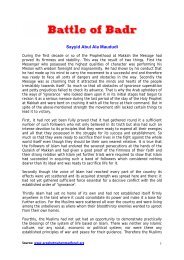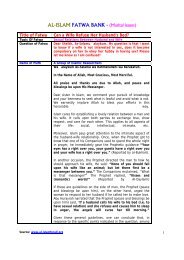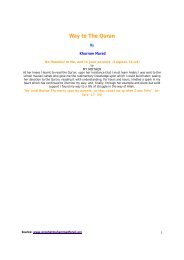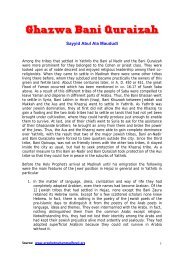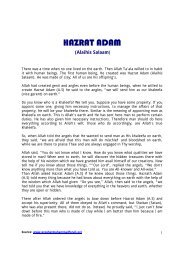the prophet muhammad (saas) - Prophet Muhammad (SAW) for All
the prophet muhammad (saas) - Prophet Muhammad (SAW) for All
the prophet muhammad (saas) - Prophet Muhammad (SAW) for All
Create successful ePaper yourself
Turn your PDF publications into a flip-book with our unique Google optimized e-Paper software.
This situation apparently indicates <strong>the</strong> invalidity of <strong>the</strong> claim that <strong>the</strong>y are ancestors of one ano<strong>the</strong>r. A<br />
paleontologist from Harvard University, Stephen Jay Gould, explains this deadlock of <strong>the</strong> <strong>the</strong>ory of evolution<br />
although he is an evolutionist himself:<br />
What has become of our ladder if <strong>the</strong>re are three coexisting lineages of hominids (A. africanus, <strong>the</strong><br />
robust australopi<strong>the</strong>cines, and H. habilis), none clearly derived from ano<strong>the</strong>r? Moreover, none of <strong>the</strong> three<br />
display any evolutionary trends during <strong>the</strong>ir tenure on earth.285<br />
Put briefly, <strong>the</strong> scenario of human evolution, which is sought to be upheld with <strong>the</strong> help of various<br />
drawings of some "half ape, half human" creatures appearing in <strong>the</strong> media and course books, that is, frankly,<br />
by means of propaganda, is nothing but a tale with no scientific ground.<br />
Lord Solly Zuckerman, one of <strong>the</strong> most famous and respected scientists in <strong>the</strong> U.K., who carried out<br />
research on this subject <strong>for</strong> years, and particularly studied Australopi<strong>the</strong>cus fossils <strong>for</strong> 15 years, finally<br />
concluded, despite being an evolutionist himself, that <strong>the</strong>re is, in fact, no such family tree branching out<br />
from ape-like creatures to man.<br />
Zuckerman also made an interesting "spectrum of science." He <strong>for</strong>med a spectrum of sciences ranging<br />
from those he considered scientific to those he considered unscientific. According to Zuckerman's spectrum,<br />
<strong>the</strong> most "scientific"—that is, depending on concrete data—fields of science are chemistry and physics. After<br />
<strong>the</strong>m come <strong>the</strong> biological sciences and <strong>the</strong>n <strong>the</strong> social sciences. At <strong>the</strong> far end of <strong>the</strong> spectrum, which is <strong>the</strong><br />
part considered to be most "unscientific," are "extra-sensory perception"—concepts such as telepathy and<br />
sixth sense–and finally "human evolution." Zuckerman explains his reasoning:<br />
We <strong>the</strong>n move right off <strong>the</strong> register of objective truth into those fields of presumed biological science,<br />
like extrasensory perception or <strong>the</strong> interpretation of man's fossil history, where to <strong>the</strong> faithful [evolutionist]<br />
anything is possible - and where <strong>the</strong> ardent believer [in evolution] is sometimes able to believe several<br />
contradictory things at <strong>the</strong> same time.286<br />
The tale of human evolution boils down to nothing but <strong>the</strong> prejudiced interpretations of some fossils<br />
unear<strong>the</strong>d by certain people, who blindly adhere to <strong>the</strong>ir <strong>the</strong>ory.<br />
Technology In The Eye and The Ear<br />
Ano<strong>the</strong>r subject that remains unanswered by evolutionary <strong>the</strong>ory is <strong>the</strong> excellent quality of perception<br />
in <strong>the</strong> eye and <strong>the</strong> ear.<br />
Be<strong>for</strong>e passing on to <strong>the</strong> subject of <strong>the</strong> eye, let us briefly answer <strong>the</strong> question of "how we see". Light<br />
rays coming from an object fall oppositely on <strong>the</strong> retina of <strong>the</strong> eye. Here, <strong>the</strong>se light rays are transmitted<br />
into electric signals by cells and <strong>the</strong>y reach a tiny spot at <strong>the</strong> back of <strong>the</strong> brain called <strong>the</strong> centre of vision.<br />
These electric signals are perceived in this centre of <strong>the</strong> brain as an image after a series of processes. With<br />
this technical background, let us do some thinking.<br />
The brain is insulated from light. That means that <strong>the</strong> inside of <strong>the</strong> brain is solid dark, and light does<br />
not reach <strong>the</strong> location where <strong>the</strong> brain is situated. The place called <strong>the</strong> centre of vision is a solid dark place<br />
where no light ever reaches; it may even be <strong>the</strong> darkest place you have ever known. However, you observe a<br />
luminous, bright world in this pitch darkness.<br />
Please visit FREE e-libraries:<br />
www.al-islam<strong>for</strong>all.org www.quran<strong>for</strong>all.org www.<strong>prophet</strong><strong>muhammad</strong><strong>for</strong>all.org<br />
94




